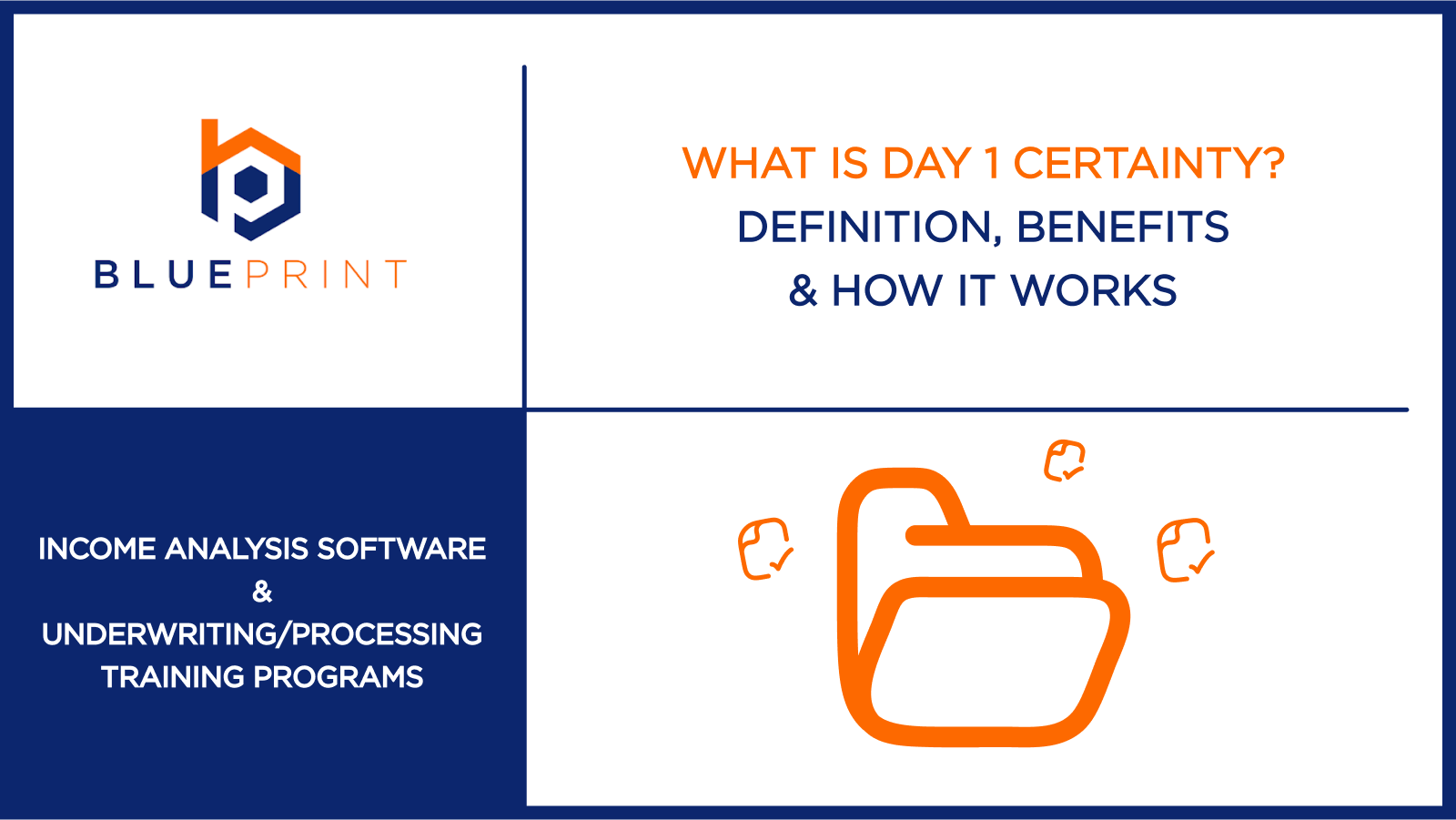Repurchase demands, documentation delays, and inconsistent underwriting still challenge even the most efficient lending teams. Day 1 Certainty is designed to fix that. By verifying borrower income, employment, and assets through approved vendors, it offers lenders relief from certain representations and warranties and a faster, cleaner path to loan approval.
This guide breaks down how Day 1 Certainty works, what it covers (and what it doesn’t), and how tools like IncomeXpert help fill the gaps by standardizing income analysis and supporting compliant, audit-ready files.
Main takeaways from this article:
- Day 1 Certainty is a Fannie Mae initiative aimed at reducing risks in the mortgage lending process and enhancing underwriting processes.
- Key components of the program are validation services, automation benefits, and representatives and warranties relief.
- The program streamlines the loan approval process through steps involving borrower authorization, vendor reports, and DU validation.
- Certain scenarios, like self-employment or non-traditional income, may not be applicable under Day 1 Certainty.
- IncomeXpert supports the program by automating income verification and ensuring regulatory compliance with audit-ready documentation.
What is Fannie Mae Day 1 Certainty?

Introduced in 2016 and refined every year since, Day 1 Certainty is a program designed to provide lenders with greater confidence in their mortgage origination process. It allows Fannie Mae’s Desktop Underwriter (DU) to match third-party reports to loan-file data digitally.
When the data aligns, DU issues a validation message that waives customary post-funding liabilities for that element of the file. By validating key loan components upfront through Fannie Mae’s DU validation service, lenders gain earlier clarity on loan salability, auditors face fewer repurchases, and borrowers get “clear to close” sooner.
How lenders benefit from Day 1 Certainty

Day 1 Certainty offers multiple benefits that touch credit risk, customer satisfaction, and internal costs. The program:
- Reduces rep and warrant risk: DU validation shifts the burden of future buy-backs to Fannie Mae for any component it validates. By moving much of the liability off the balance sheet, lenders protect capital and lessen reserve requirements.
- Accelerates the loan process: Digital validation replaces paper VOEs, bank statements, and manual data entry. Closings move quicker because the file arrives in underwriting with verified numbers and fewer suspense items.
- Enhances borrower experience: Borrowers authorize data pulls online instead of hunting for documents, which makes the mortgage process more streamlined and predictable with shorter application sessions and fewer repeated requests from processors.
- Improves underwriting accuracy: Automated cross-checks flag data mismatches early. Underwriters focus on judgment calls, not key-strokes, which raises loan-file quality and reduces suspense conditions. This accuracy is particularly important when evaluating loans related to affordable rental housing.
- Drives operational efficiency: With fewer document touches, staff can review more files per day, helping teams control per-loan costs even as volumes swing.
How does Day 1 Certainty work?

The Day 1 Certainty process leverages technology and data validation alongside following a defined sequence of steps. Here are the five steps that bring it into the underwriting workflow:
Step 1: Borrower provides authorization
The first step in Day 1 Certainty involves the borrower granting explicit consent to the lender to access and verify their income, employment, and asset information electronically. This authorization typically occurs during the loan application process.
Step 2: Lender obtains reports from approved vendors
Upon receiving borrower authorization, the lender initiates requests to Fannie Mae-approved third-party vendors for the necessary verification reports. These reports contain data related to the borrower’s income, employment history, and asset holdings, sourced directly from employers, financial institutions, and other reliable sources.
Step 3: Submit file to Desktop Underwriter (DU)
Once the lender has gathered the validation reports, the complete loan file, including these reports, is submitted to Fannie Mae’s DU. DU runs an automated evaluation of the loan file and the validated data against Fannie Mae’s underwriting guidelines.
Step 4: Receive validation findings
DU analyzes the submitted information, including the data from the validation reports. If the system successfully validates the borrower’s income, employment, and/or assets according to Fannie Mae’s criteria, the DU findings will indicate eligibility for relief from certain representations and warranties related to the validated data.
Step 5: Proceed with streamlined underwriting
With successful validation findings from DU, lenders can move forward with the underwriting process with increased confidence in the accuracy of the verified information. This can potentially lead to a more focused and less cumbersome underwriting review, as the need for extensive manual verification of these data points may be reduced.
When Day 1 Certainty doesn’t apply

There are some situations where Day 1 Certainty may not be applicable or provide relief from representations and warranties. These situations may result from:
Self-employment income
Verifying income for self-employed individuals often involves a more intricate analysis of business financials, tax returns, and other documentation that may not be fully addressed by automated validation services. Consequently, Day 1 Certainty may offer limited or no relief for the verification of self-employment income.
Non-traditional income types
Borrowers may have income from various non-traditional sources, such as gig economy work, royalties, or trust distributions. These income types can have unique characteristics and documentation requirements that may fall outside the scope of standard automated validation processes used in Day 1 Certainty.
Changes in borrower data
The validity of Day 1 Certainty findings is based on the borrower’s information at the time of validation. If there are significant changes in the borrower’s income, employment, or assets between the time of validation and the final loan closing, the initial findings may no longer be reliable, and the associated rep and warrant relief may not apply.
Ineligible DU Findings
If the DU analysis and verification report data identifies discrepancies, inconsistencies, or other issues with the data, even after utilizing the validation services, the loan file may receive findings that deem it ineligible for Day 1 Certainty rep and warrant relief. This could necessitate further manual underwriting and investigation.
How IncomeXpert complements Day 1 Certainty
While Day 1 Certainty covers core wage earners, lenders still face gray areas like complex self-employment, layered rental income, or mixed W-2/1099 earnings. IncomeXpert helps underwriters navigate these scenarios by delivering consistent income analysis and documentation for income types that aren’t eligible for automated validation.
- Handles complex income scenarios: IncomeXpert’s strength lies in its ability to analyze intricate income profiles that go beyond standard employment and asset verification. It can effectively handle multiple income sources, self-employment income, rental income, and other complex scenarios by systematically evaluating various income documents and applying relevant guidelines.
- Provides audit-ready documentation: The tool generates detailed and audit-ready income calculation reports. These reports provide a clear and transparent breakdown of how income was analyzed and verified, along with supporting documentation. This thorough record-keeping is essential for maintaining compliance, facilitating internal reviews, and addressing potential audit requirements.
- Enhances underwriting efficiency: IncomeXpert automates the often time-consuming and complex process of analyzing diverse income sources and generating comprehensive documentation, allowing underwriters to operate more effectively. It frees up their time to focus on other critical aspects of loan risk assessment and decision-making, leading to faster turnaround times and improved overall underwriting quality, especially in cases that fall outside the straightforward parameters of Day 1 Certainty’s automated validation.
Strengthen your underwriting process with IncomeXpert
Fannie Mae’s Day 1 Certainty initiative offers lenders a valuable framework for reducing risk and improving loan processing through upfront data validation. While it provides significant benefits, certain complex income scenarios and data limitations may fall outside its scope. IncomeXpert offers a powerful solution that works well with the Day 1 Certainty program, particularly when tackling the complexities of diverse income scenarios.
The tool provides the in-depth income analysis and audit-ready documentation you need to manage complex borrower profiles confidently. By smoothly integrating with your existing workflow and enhancing the benefits of Day 1 Certainty, IncomeXpert empowers your underwriting team to make faster, more informed decisions.
Discover how it can strengthen your underwriting process and your standing in the mortgage industry – request a demo today!
Day 1 Certainty FAQs
What does Day 1 Certainty mean?
It is Fannie Mae’s term for the rep-and-warrant relief granted when DU successfully validates employment, asset, or property data through approved third-party income reports.
Does Freddie Mac have a Day 1 Certainty?
Freddie Mac offers a similar program in Loan Product Advisor called Asset and Income Modeler (AIM), which provides comparable rep-and-warrant relief for validated assets, income, and employment.

